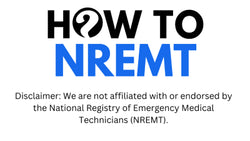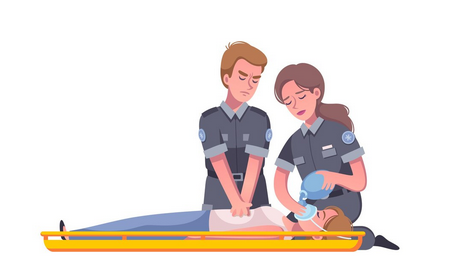Most students cram everywhere. That leads to burnout, but what if you could target study time strategically? The NREMT outlines specific domain percentages. That’s your key. If you aim for the biggest domains first, you get the most score impact. We want you to study smart, not hard.
In this post, we’ll break down each NREMT content domain. We’ll show you how to focus hours by weighting, and we’ll share tips on using NREMT cognitive exam practice to reinforce your study. Track your progress. Study with purpose. Pass confidently.
1. Understand the Domain Weighting
The NREMT exam assigns weight to each domain. Knowing these percentages helps you prioritize.
|
Domain |
Approximate % on EMT Exam |
|
Scene Size-Up & Safety |
15–19% |
|
Primary Assessment |
39–43% |
|
Secondary Assessment |
5–9% |
|
Patient Treatment & Transport |
20–24% |
|
Operations |
10–14% |
These aren’t guesses. These are the real breakdowns from NREMT test content plans. That means up to 43% on Primary Assessment. If you master that domain first, you grab nearly half the potential score.
2. Allocate Study Hours by Weight
Split your total study hours based on domain percentages. Here's a 100-hour example:
·Scene Size-Up & Safety – 17 hours
·Primary Assessment – 42 hours
·Secondary Assessment – 7 hours
·Patient Treatment & Transport – 22 hours
·Operations – 12 hours
That way, you're matching your effort to impact. This is the backbone of an effective NREMT study.

3. Use Smart Strategies Within Each Domain
Ø Scene Size-Up & Safety (15–19%)
This includes scene risk, PPE, and mechanism of injury.
·Practice quick hazard assessments.
·Learn how to size up noisy, chaotic scenes.
·Do 20 safety-focused practice scenarios.
Pro tip: Apply NREMT cognitive exam practice questions daily. Learn patterns.
Primary Assessment (39–43%)
Biggest domain. Covers airway, breathing, and circulation.
·Drill ABCs and patient priority.
·Chart dozens of vital signs with changing variables.
·Do case studies: airway obstruction, chest pain, altered LOC.
Key tip: Use NREMT exam prep platforms that mimic real TEIs. That builds muscle memory.
Secondary Assessment (5–9%)
Smaller, but it still matters. Includes history and physical exam.
·Master SAMPLE and OPQRST acronyms.
·Practice head-to-toe and focused physical exam checklists.
·Use flashcards and quick quizzes daily.
Patient Treatment & Transport (20–24%)
Procedures, meds, bleeding, shock, and environmental emergencies.
·Memorize drug dosages and contraindications.
·Simulate bleeding control, splinting, and spinal motion restriction.
·Review 20 scenario-based patient transport questions.
Operations (10–14%)
Communications, documentation, ethics, and personal safety.
·Role-play radio reports.
·Practice filling out PCR forms.
·Review legal and ethical standards.
·Use team drills to reinforce communication.
4. Schedule with Focused Blocks
Split study days into domain-focused hours.
Example weekday:
·1 hour Scene Safety + TEI drills
·2 hours Primary Assessment deep work
·30 minutes Secondary Assessment flashcards
Weekend deep dive:
·2 hours Patient Treatment scenarios
·1 hour Operations and communication review
That adds structure, momentum, and reduces guesswork. Consistency wins.

5. Integrate NREMT Cognitive Exam Practice
Passive review isn’t enough. You need to practice.
·Set weekly goals: 50–100 questions per domain.
·Use mixed quizzes to simulate a real test.
·TEI simulations are essential.
·Review rationales for wrong answers. You turn errors into wins.
This boosts retention and aligns with your study weight plan.
6. Reinforce with Spaced Repetition & Recall
Spaced repetition is proven to improve memory.
·Use flashcards daily for high-yield terms.
·Quiz yourself on medication protocols.
·Take timed quizzes to build pressure resilience.
This helps maintain long-term retention, especially in Primary and Transport.
7. Simulate Full-Length Practice Tests
A few weeks in, do full practice tests.
·Time yourself under real test conditions.
·Include all domains in one sitting.
·Analyze weak spots: which domain questions you missed?
·Adjust schedule: shift more hours to trouble areas.
This is the final tuning before test day.
8. Monitor and Adjust
Your plan isn't static. Let your performance guide the schedule.
·If Primary Assessment accuracy is above 90%, shift some time to Transport.
·If Scene Safety errors linger, give it more weekend attention.
·Treat this as a living plan—flexible, responsive, data-driven.
9. Use Domain Weighting Beyond EMT
If you study AEMT or Paramedic later, domain weighting still applies.
·For AEMT, breathe deeper into the meds and the advanced airway.
·Paramedic-level includes ECG, advanced pharmacology, and pathophysiology.
But the idea stays: bigger domains = more study hours.
10. Group Study & Peer Teaching
Joining group sessions helps reinforce domain content.
·Teach Scene Safety: drills for PPE, lifting, verbal communication.
·Run Primary Assessment workshops: airway management, breath sounds.
·Quiz each other on Secondary Assessment techniques.
Explaining concepts helps retention—peer teaching is highly effective.

Quick Recap
|
Domain |
Weight |
Study Hours (100h) |
Primary Activities |
|
Scene Safety |
15–19% |
15–19 hours |
Scenario drills, TEI questions, flashcards |
|
Primary Assessment |
39–43% |
39–43 hours |
ABC drills, case studies, TEIs |
|
Secondary Assessment |
5–9% |
5–9 hours |
SAMPLE/OPQRST drills, head-to-toe checklists |
|
Patient Tx & Transport |
20–24% |
20–24 hours |
Med dosages, simulations, scenario questions |
|
Operations |
10–14% |
10–14 hours |
Communications practice, PCR drills, ethics review |
With this plan, your NREMT study becomes strategic and focused.
Keeping Your Eyes on the Prize
We know the NREMT exam can feel overwhelming, but domain weighting cuts that anxiety. It gives your NREMT study a purpose. This targeted method works for many of our students report first-attempt pass and high confidence.
Focusing your NREMT study by domain weighting changes everything. You study smart, pass strong. Let this guide be your roadmap, and remember: your first-attempt success is within reach.
Frequently Asked Questions
Q: What if I only study by domain percentages?
A: You’ll build a strong foundation where it matters most. Minor domains still get coverage, but major wins come from big domains.
Q: How often should I take full practice tests?
A: Every two weeks, once you’ve logged 40+ hours. That gives enough data to adjust.
Q: How many TEI questions should I do weekly?
A: Aim for 15–20 TEIs per week, scattered across domains. Familiarity breeds calm.
Q: Can I modify the schedule based on strengths?
A: Yes. This isn’t rigid. Adjust based on practice test results or confidence levels.
Q: Do you offer resources by domain?
A: Absolutely. Our platform breaks down quizzes and lessons per domain. You can track time spent and accuracy.
Ready to Take the Next Step?
Unlock Your NREMT Success with How To NREMT!
We offer domain-focused NREMT study tools, TEI simulations, and NREMT test preparation strategies that match this weighting plan. Our platform aligns with your targeted hours, and our coaches help you adapt on the fly.
Start your study with confidence. Let us guide your domain strategy and TEI prep. You don’t have to do this alone. Learn more at How To NREMT and set your NREMT exam prep plan in motion today.

